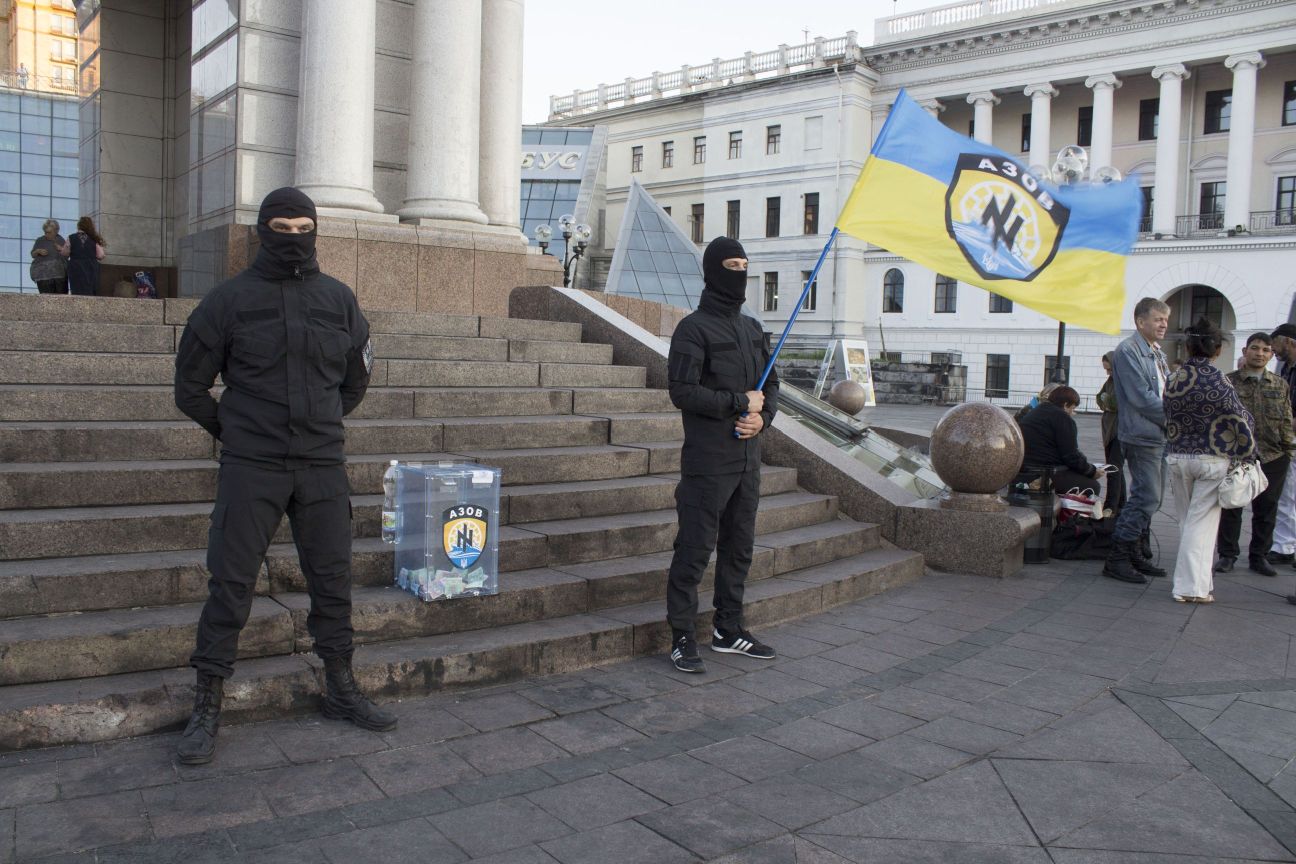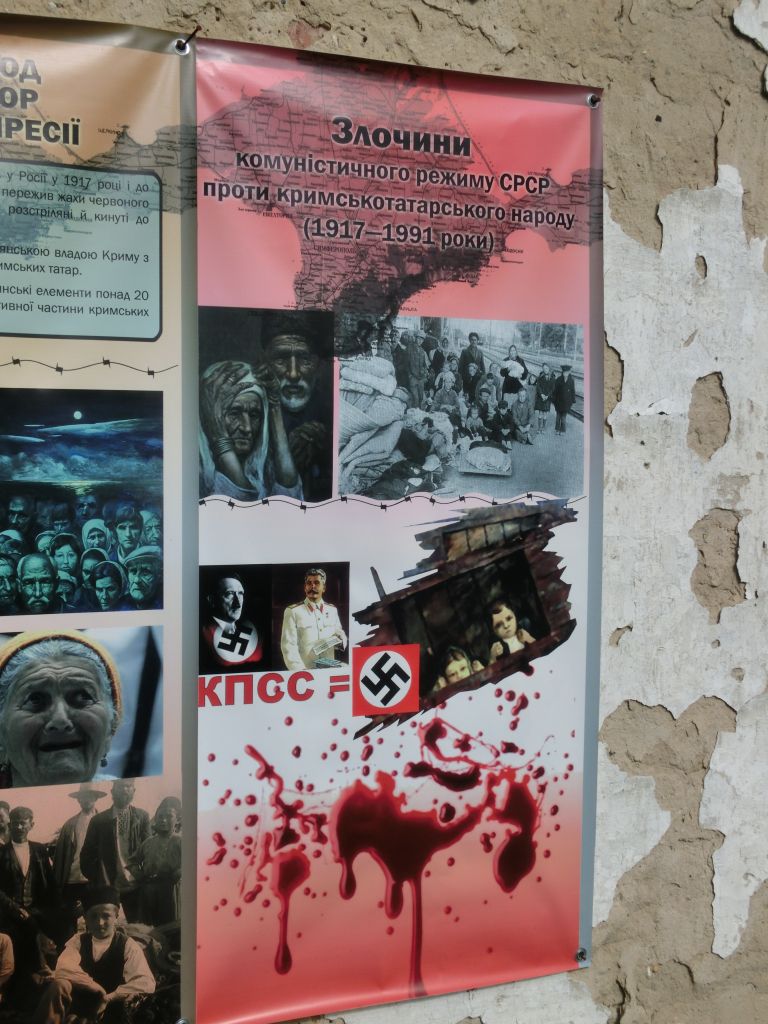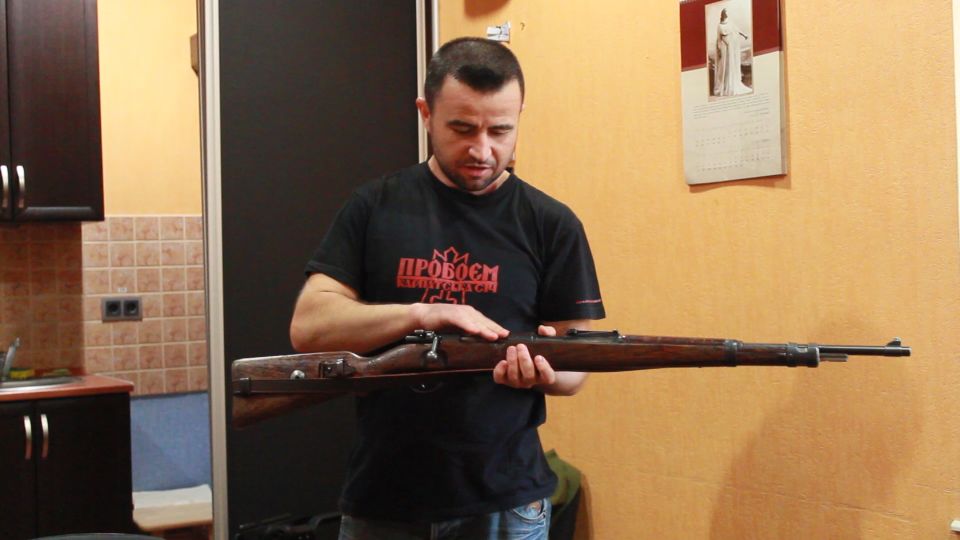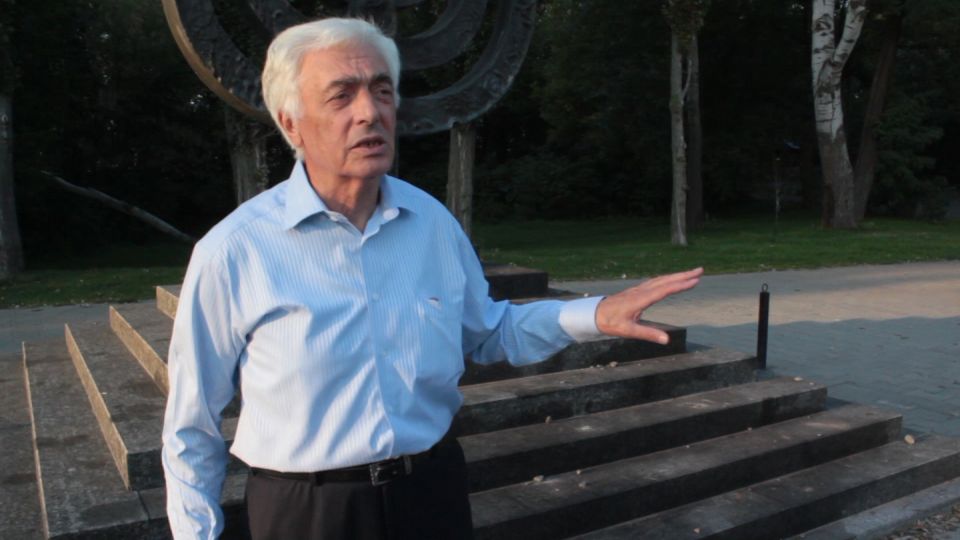O P I N I O N / T R A V E L L O G
by Frank Brendle (Berlin)
Editor’s note: The author travelled through Ukraine in autumn 2014 with a team from the Berlin-based Educational Center for Peace Research and Pinima productions. A German version of this report appeared in www.bildungswerk-friedensarbeit.org. This English version has been approved by the author. The photographs were supplied by Frank Brendle and Pinima productions, Berlin. Any re-use should credit each photo appropriately. For background on the Ukrainian Holocaust see a recent US Holocaust museum (USHMM) report, and the Defending History work by Grzegorz Rosslinski-Liebe and Per Anders Rudling; also our Ukraine section and page on 2014 international media.
◊
It’s a late summer night in Lviv and we have our first encounter with Ukrainian civil society: A demonstration of bicyclists. The words “critical mass” are written on their banners, and they are fighting for more space on the roads. Just like in Germany. But something else is different than in Germany: The leader of the demonstration is shouting “Slava Ukraini!” and the crowd shouts back: “Heroiam Slava” (Glory to Ukraine – Glory to the Heroes). Then comes the next organized chant and reply-to-the-chant: “Glory to the Nation – Death to the Enemies.” fun-in-participation factor is multiplied as passers-by shout the chant, eliciting the expected reply from the marchers.
The problem is that these are the slogans of the fascist Organization of Ukrainian Nationalists (OUN) and their military wing founded in 1942, the Ukrainian Insurgent Army (UIA, or UPA as known by their Ukrainian name). That organization, that “almost” fought the Soviets, rarely fought against the Germans, distinguished itself in history by killing (at least) tens of thousands of Poles and Jews. Today, at least the first slogan (that of the OUN) is a common greeting of the selfsame Ukrainian patriots who consider themselves to be “pro-European.”

Kiev, Maidan Square, Sept. 2014: Masked men guard the donation box for the Azov battalion that sports Nazi symbols. Image: Pinima.
Since Ukraine became independent in 1991, the politics of history has been its political arena. Many leaders who are anti-Russian and professedly pro-Western want to rehabilitate the fascist forces of the interwar period and the de facto enablers and indeed enactors of Hitler’s final solution during the Holocaust. Since the banners of OUN and their leader Stepan Bandera were placed in the first line of the early 2014 Maidan Square protests, to little foreign chagrin, their use has become widely accepted in society.
How far-reaching is this and what kind of effects does this have on the remembrance of the Holocaust?
Lviv (Polish Lvov, Lemberg in times of the Habsburg Empire) has been the stronghold of (west) Ukrainian nationalism since the end of the nineteenth century. Here the extreme right-wing party Svoboda (“Freedom”) gathered up to thirty and more percent in the elections. The streets have names like “Heroes of UPA” or are named after nationalist leaders. On the market places you can buy cups, T-shirts and scarfs with pictures of Bandera and his comrades. Even the portrait of Vladimir Putin is there: on a roll of toilet paper or a doormat. The Boulevard Stepan Bandera connects the larger-than-life-sized monument of the OUN´s leader (ironically just like the Lenin monuments in Soviet times) with the “Monument to the Victims of Communist Crimes.” Nearby in a former prison is the “Museum of the Victims of the Occupying Regimes.” The NKVD (Soviet security agency) in June 1941 murdered several thousand prisoners, so undoubtedly there is a reason for commemoration. But they forget that the Nazis and their local collaborators, including some of the same OUN/UPA “heroes,” forced Jews into the prison, accusing them of being responsible for the assassinations and killing some four thousand of them in a pogrom – that fact is without any mention here. This location is telling about glory and spirit of sacrifice of Ukrainians only.

In the Museum of the Victims of the Occupying Regimes (Lviv). Image: Frank Brendle.
It is the same in the so-called “Museum for the Struggle for National Liberation,” which was opened two years ago in a ceremony including veterans of the UPA. Here the unsuccessful fighters for independence of the years after 1917 are represented in chronological order, with the same standing as the militias of the OUN, the UPA and even the Waffen SS Division Galicia, all as alleged representatives of a continuous “freedom fight.” We see the same logic at the Litshakivski cemetery, where the soldiers who died in the current battles in eastern Ukraine are embedded side by side with fighters of the UPA and alongside an obelisk honoring the Waffen-SS. There is also a monument to Roman Shukhevich here. This man was the commander of the Wehrmacht´s “Nightingale” battalion and later became head of the UPA.
There is not a thing that recalls the Holocaust in Lviv, a city where almost a third of the population was Jewish when the German army occupied it. The Jewish community established a monument at the entrance of the former ghetto, but there is nothing “official.”
The Jewish organization for social welfare and education “Hesed Arieh” six years ago introduced for wider educational use a school lesson about Jewish culture and the Holocaust. Included was a film showing, in some pictures of only some seconds, how Ukrainians celebrated the invasion of the Germans in 1941. Politicians from Svoboda protested, the general prosecutor investigated alleged “anti-Ukrainian activities,” and Hesed-Arieh had to appear before a local commission. “In the circumstances, they didn´t allow us to continue our work in the schools,” reports Irina Belous Hesed-Arieh.
One of the people who wants to boost the remembrance of the Holocaust in Lviv is film producer Taras Tsholyi. He has a very specific approach. He had the idea to erect a “Territory of Terror” on the ground of the former ghetto, where after 1945 the Soviets constructed a prison of the NKVD, and here is the point to say hello to the theory of “equivalence of all totalitarianism” and red = brown politics! It should be “as interactive as possible,” says Tsholyi, including re-erected barbed wire fences, barracks and watchtowers. “Some call it Disneyland,” concedes Tsholyi, who is sure that this kind of installation will be much more interesting for young people than old-school museums.

Taras Tsholyi. Image: Pinima.
When we arrive at Tsholyi’s office, we are for some seconds, breathless: The thirty-something is just putting an old rifle in the trunk of his car. After the interview, he will go into the forests, for private military training with some of his friends. They are preparing for conscription, and nobody is relying on the official army´s training. Tsholyi got the rifle from an uncle – it is an original Wehrmacht carbine produced in the 1940s. To match that, Thsolyi is wearing a T-shirt with the banner of “Carpathian Sich,” a branch of the OUN which fought in 1938 for the independence of Carpathian Ukraine.
Tsholyi wants, without doubt, to honor the OUN and the UPA, and his Facebook page sports a large UPA banner. However we get the clear impression that he is absolutely interested in commemorating, inter alia, the Holocaust too. “There were people who knew where the Jews hid their gold, and they handed them over to the Germans,” he says. And he concedes, anyhow, that there were “mistakes” by the UPA, since some of their commanders assaulted Polish villages in the region adding the ubiquitous equals sign: “just like Polish commanders assaulted Ukrainian villages.”
Apart from that, his views are appalling. Tshoyli says: “Of course the biggest part of the memorial complex will be dedicated to the victims of the Soviet regime, because that took longer and was likely the more terrible.”
He is citing his grandmother, who always declared: “The Germans were terrible, but there was nobody more terrible than the Russians.” To blame UPA for having murdered Jews is, following Tsholyi, “illogical” for the UPA sought the assistance of the USA, and “the USA is dominated by Jewish capital, so tell me the purpose why they would have committed crimes against the Jews.”
The city council of Lviv made Thsolyi a “director” but in fact, this is more of an honorific title, for he gets not more than some pocket money, he reports. The building costs are to be financed by private sponsors, and currently the project remains on ice.
The gap in Holocaust remembrance in Ukraine is also evident in Babi Yar, only a few kilometers from downtown Kiev, where the Nazis and Ukrainian policemen shot 33,771 Jewish inhabitants on September 29 and 30, 1941, accurately counted by the SS. In the 1960s, a monument for the murdered “peaceful soviet citizens” was erected, ignoring their Jewish origin. It was only after independence that the Jewish community set up its own monument. Several Ukrainian governments of different political orientation announced they would establish a Holocaust museum, but the projects ended with the mere laying of foundation stones.
By contrast, the announcements for a Holodomor memorial were fulfilled, when it was established in 2008 on the Dnepr Hills. It is dedicated to the victims of the famines in soviet Ukraine, especially to the three to four million victims of 1932 and 1933.
Historians agree mostly on the co-responsibility of the Soviet leaders, who artificially worsened the famine. But the memorial interprets the famine in a highly suggestive and manipulative exhibition as the purposeful genocide by Russians and Bolsheviks against the Ukrainian people. The fact that people of other origin – Russians, Jews, Germans, Roma – also starved to death is not mentioned here. A historian of the memorial describes the aim: “Here the different cultures in the western, the central and the eastern part of Ukraine are unified by the knowledge of the tragedy that happened to the Ukrainians.”
Thus, it is about creating a “national identity” on the basis of purely ethnic Ukrainian suffering.
Boris Zabarko is the 79 year old Jewish historian who survived the Holocaust in the ghetto of a small shtetl in the Romanian occupied zone.

Boris Zabarko. Image: Pinima.
Today he is chairman of the association of former prisoners of ghetto and Nazi concentration camps. He says:
“Following the Orange Revolution the Holodomor has become the center of scientific research. The Holocaust was regarded as marginal Jewish issue. The ‘Ukrainian Institute of National Remembrance’ established under former president Viktor Yushchenko, praised the fighters of UPA, the leaders of OUN, the collaborators, and therefore even those who have participated in anti-Jewish actions in western Ukraine. I know all too well what role Bandera and his men played, that they were active participants in the final solution of the Jewish question.” Talking about the Holocaust would mean to talk even about the collaboration. “But here among us this theme is rather to be concealed.”
One of the champions of the Maidan events is Volodymyr Viatrovych. He might also be the most important whitewasher of the OUN in all Ukraine. After the Orange Revolution he led the “Institute of National Remembrance” mentioned by Zabarko, the only historical project that is financially funded by the state (and Holodomor commemoration is its major outcome). Under Yanukovich he was degraded to a simple employee, but since April this year Viatrovych is back again at the top of the institute, having under his control a big part of the historical documents of the OUN and the UPA.
In the interview he repeated several times that all negative aspects and reports about the OUN originates from Soviet propaganda. I asked him, how does it come that several Western historians, just in recent years, published extensively about the fascist character and the crimes of OUN, about the mass murder of Poles and others? Says Viatrovych: “These historians are influenced by the Soviet presentations.”
The adherents of Bandera were “the first to fight illegally against Nazi Germany,” assures us Viatrovych, stressing in the same breath that any cooperation with the Nazis has been only of practical, not ideological nature. Today the Bandera nationalists are “an example for many Ukrainians, an example of uncompromising and sacrificial struggle for an independent state.” Viatrovych points to an alleged consequence of the Russian propaganda that is blaming the Maidan movement as a whole as a fascist “Banderovtsy” phenomenon. “Yes, we are Banderovtsy, we also struggle for the independence of Ukraine.”
Viatrovych comes from Lviv. There, historian Jaroslav Hrytsak, professor at the Catholic University, doesn’t have a high regard for him: He believes his colleague stands in the tradition of the exiled Ukrainians “that contaminated the historical research and the memory.” Hrytsak continues: “Viatrovych is playing with documents” in order to strengthen the Bandera myth, “and I regard that as treason of his professional education.”

Jaroslav Hrytsak. Image: Pinima.
Bandera, says Hrytsak, is popular because people do not consider the substantial gap between the idealized image of their anti-Russian freedom fighter and the historical facts: “For sure Bandera was anti-Russian, but, also for sure, he wasn’t opponent of an authoritarian state.” Hrytsak calls the Bandera wing of the OUN xenophobic and anti-European. If Bandera knew that people are connecting him with pro-European and liberal values, he “would turn over in his grave.” Ten years ago Hrytsak published an article criticizing the OUN, as “an invitation for a discussion.” He talked there about the mass murders of Poles and the antisemitism of theUPA. This invitation has not been accepted, but alarmed Svoboda: “Several of their leaders threatened me publically and promised to find me a nice prison cell when they come to power.”
What will happen next? Even if the majority of the (self-) declared “Banderovtsy” don’t have any consciousness of the crimes of Bandera and his adherents (and supposedly they don’t want to know anything about this), it remains the historical fact that he was the commander of a fascist criminal organization. And even if the Russian propaganda exaggerates many things, it certainly did not invent the Nazi-spirited crimes of the OUN.
But with the exception of some very few Jewish activists nobody seems willing to talk about that. The few progressives and leftist activists are following other issues, they are not worried about Bandera.
Even critical historians don’t want to debate publicly about the OUN and Bandera. Georgyi Kasianov, working at the Academy of Sciences in Kiev and in the past a very sharp-tongued critic of the ruling politics of history, argues it is the best to avoid discussions about historic themes: “If the western Ukrainians want to establish a cult about Bandera and want to speak about the heroes of Ukrainian Insurgent Army, they should do this freely, and should do this there, they should not go to Donetsk and impose their values of historical memory there; the same implies to the east of Ukraine.” Kazianov concludes with an ironic subtext, recommending some kind of “peaceful co-existence” of Bandera and Lenin.
Similarly Hrytsak argues for a “pact of amnesia” perhaps like in Spain after the death of dictator Franco in 1975. “In my opinion Ukraine is not ready for historical debate,” he says, it would be even “suicidal” for the country “if we would discuss Bandera. You Germans will not understand this,” he adds.
In reality, such a truce in politics of memory does not exist. Although President Poroshenko called the veterans of the Soviet Red Army and those of UPA several times, “defenders of Ukraine” he has since established October 14 as national holiday. It is the day celebrated by nationalists as the day of foundation of the UPA.
While the (potential) critics of Bandera ceased to criticize him, his adherents don’t even think about remaining silent. Where ever they come, after pulling down Lenin they institute Bandera marches, and their interpretations are backed, with the assistance of Viatrovych’s “Institute of National Remembrance” from the very top of the state. Jewish and Polish citizens of the country need to continue to see how deliberate killers of people of their ethnicity, only on the basis of ethnicity, are made into national heroes.